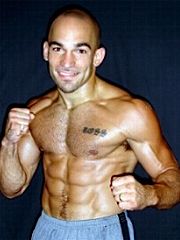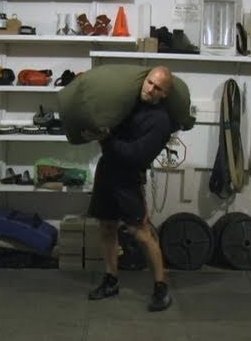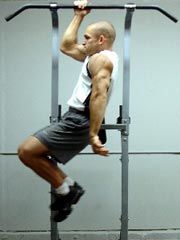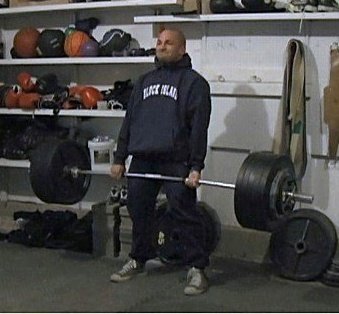“The best interview to date with Ross.” – Rusty Moore of FitnessBlackBook.com
Allow me to introduce you to Ross Enamait, who is a coach to professional fighters and has been a hardcore athlete for most of his life. I’ve admired Ross for a number of reasons, but I think one of his finest qualities is his old school nature combined with a talent for innovation.

Not too long ago, I decided I wanted to get to know him a little better. So, I sent off a list of interview questions to see what he’s all about. I’ve followed Ross on and off over the years, but honestly, I wasn’t entirely sure what to expect. What I did know is that whatever it amounted to, it’d be good. Ross is one of those guys who has been around the block a few times. He knows his craft better than most athletes and fitness trainees ever will because he’s been training and coaching with extraordinary success for a long time.
It comes as no surprise that this is one of the best interviews I’ve ever featured here on Physical Living. If you want to get a glimpse into the reality behind what it takes to achieve a high standard of fitness, you will enjoy this interview. Ross pulls no punches. He’s got nothing up his sleeve. And if you follow his advice, you too can achieve a high standard of fitness.
And if you get just one key insight from this interview, then it’ll have been worth it. And I’d be willing to wager that you’ll a lot more than that.
Let’s dive right in.
Can you tell us a little bit about yourself including your background in athletics and fitness and also what you do today?
I’ve been involved in athletics my entire life. I don’t recall a time when I wasn’t somehow involved in a competitive sport. I started as a young child and continued through college and beyond. I did however suffer several hand fractures as a boxer so I eventually transitioned to coaching. I now train professional fighters. I’ve done so for many years and have what I consider to be the best job in the world.
OK, I’ve seen you use barbells, dumbbells, sandbags, kegs, weighted vests, ab wheels, jump ropes, resistance bands, and practically every other type of home gym equipment you can think of – and then some. But what’s the deal – no shake weight?
The shake weight symbolizes everything that is wrong with the fitness industry today. It’s a product that is more gimmicky than anything I’ve ever seen. Yet despite the countless parodies and jokes, I read that the shake weight brought in more than 40 million dollars in revenue in less than a year. Such a financial success shows that the consumer is both misinformed and desperate to improve.
Makers of products like these are only concerned with their bottom line. The goal isn’t to improve people’s lives, but rather to see how much revenue can be generated in a short period of time.
The take home lesson from the shake weight is simple. Consumers must do their homework. Be a skeptic and don’t be so impulsive. If what is being advertised sounds too good to be true, it probably is. Instant gratification doesn’t exist in the world of health and fitness. If you wish to improve, patience, diligence, and consistency are more important than anything.
What are some of your favorite training tools and why?
I can’t pinpoint a single tool as I have worked with so many different things over the years. I have used free weights, odd objects, bodyweight exercise, medicine balls, large tires, sledgehammers, resistance bands, and weighted vests, just to name a few. I also have loads of homemade contraptions that I’ve put together over the years. Each tool is potentially valuable depending on what you are trying to develop. To label a tool or group of tools as personal favorites wouldn’t be accurate for me. My own preferences vary from time to time depending on the goals that I’m working to achieve.
You and I both know that you can’t buy fitness. That said, for someone who’s interested in outfitting a home gym with limited funds and/or limited space, what do you think would be the best overall investment(s)?
I’m not a fan of generalizations so I can’t make a universal recommendation regarding which tools an individual should purchase for a home gym. An individual could do quite well with nothing but his own bodyweight. Perhaps then a pull-up bar is one worthwhile suggestion.
 There are also plenty of inexpensive options that an individual could add to spice up his home-based training. One example that I recently posted to my Youtube channel shows how a simple pair of furniture sliders can provide a full body workout.
There are also plenty of inexpensive options that an individual could add to spice up his home-based training. One example that I recently posted to my Youtube channel shows how a simple pair of furniture sliders can provide a full body workout.
http://www.youtube.com/watch?v=ykf6aQGtrQg
Clearly, the sliders are just one of many options but they’re a prime example of how you can do well with little or nothing in terms of equipment.
In summary, I’d first consider the goals and needs of the individual. For example, a competitive boxer would probably want his own heavy bag. A powerlifter would prefer a barbell. The tools that make sense for the individual depend on what he is trying to develop. For the non-competitive crowd, I would start with a simple set-up. Don’t be fooled to believe that you need an elaborate home gym to progress. You can start with little or nothing and eventually acquire additional tools over time. You’ll also see that there are plenty of homemade options that require little or no craftsmanship. A homemade sandbag is a prime example. Such a tool is easy to construct and can provide a tremendous full body workout.
What is one piece of equipment that most people don’t have or use, but you think would be a great addition for many people?
As with the previous question, it is difficult to pinpoint a single piece of equipment. Using myself as an example, I have put together many homemade tools that have been quite valuable. I couldn’t say that one ranks above all others however. The value of a particular tool will vary depending on the needs of the individual.
One of the problems with the industry today is that generalizations are often pushed towards specific populations. It is important to remember that training is an individualized process. No two people are the same. We are all unique in terms of goals, past experiences, strengths and weaknesses, interests, and more. There isn’t a single tool or style that should be applied to the masses. There are even times when I have athletes who compete in the same sport doing entirely different things in the gym. The fact that two athletes compete in the same sport doesn’t mean they have the same needs. A trainer must evaluate each athlete individually. Cater the training based on the uniqueness of the individual, as opposed to telling everyone to blindly follow the same road.
Note From John: Here are some more budget training ideas from one of Ross’s videos.
You have a knack for creating do-it-yourself solutions when a training tool either isn’t meeting your needs or you don’t want to pay almost $200 for what amounts to a couple of straps and handles (I won’t mention names!). What are the benefits of building your own equipment and what are some of the more popular/useful options out there that someone could consider? If you’ve got some tutorials, please include some links, too.
There are two potentially key benefits to constructing your own equipment. First would be building a piece of equipment that doesn’t have a commercial counterpart. And second would be to build a tool at a fraction of the cost of the commercial option. I can provide an example for each.
In early 2011, I built a hamstring training tool that I hadn’t seen previously. The design that I built in 2011 was actually a modification to a previous idea that I built in 2010. In each case, I started with a general idea and searched for commercial options. When I saw that none were available, I took matters into my own hands and constructed it myself. The inexpensive tool that came as a result of my brainstorming has proved to be one of my favorite hamstring exercises. You can see a video demonstration of the tool at the 5:15 mark within the following video:
As for the second potentially useful reason for building equipment, there are significant cost savings in many cases. For example, consider the high price of many commercial sandbags. I have used homemade sandbags for 15+ years now. They work just as well at a fraction of the cost. I’ve also built several rugged suspension trainers for approximately $20 each. They too work as well as any commercial option.
It is also worth noting that homemade equipment can actually be stronger than some of the commercial options. My homemade dip belt is stronger than anything I’ve ever seen on the market. I built it for a fraction of the cost. The chain used for my belt is much stronger and thicker than anything you will find at the sporting goods store.
Building something doesn’t mean you are somehow doing yourself a disservice. In many cases, you may actually be creating a stronger and safer tool.
As for tutorials, my Youtube channel is filled with homemade equipment ideas. You will find several within:
http://youtube.com/rossenamait
Note from John: I’ve been a subscriber for years, and you should be, too!
What is the value of bodyweight training, and how do you think this method fits into the overall picture when it comes to fitness training and strength and conditioning? Is it merely a good supplement to equipment-based exercise, or can it be used as a stand alone training modality?
The possibilities for bodyweight training are endless. There are loads of athletes who have thrived on nothing but bodyweight exercise.
 It is worth noting though that different people have different interpretations of what constitutes bodyweight training. Some consider bodyweight exercise to mean exercise that is devoid of any equipment. Personally, I’m not too concerned about precise definitions. If a simple piece of equipment can enhance a bodyweight movement, I’m all for it. For example, I will often add a weighted vest to a traditional bodyweight exercise. I will also use bodyweight-based tools such as a suspension trainer, an ab wheel, a pull-up bar, furniture sliders, and so on.
It is worth noting though that different people have different interpretations of what constitutes bodyweight training. Some consider bodyweight exercise to mean exercise that is devoid of any equipment. Personally, I’m not too concerned about precise definitions. If a simple piece of equipment can enhance a bodyweight movement, I’m all for it. For example, I will often add a weighted vest to a traditional bodyweight exercise. I will also use bodyweight-based tools such as a suspension trainer, an ab wheel, a pull-up bar, furniture sliders, and so on.
With such an approach, numerous progressions and variations become available to you. There is always a way to take a common exercise and make it more difficult. There is always a challenging progression or variation that you can work towards achieving.
One of the classic downfalls to bodyweight training comes from those individuals who aren’t knowledgeable on the subject. Many people think of bodyweight exercise as nothing more than squats, pushups, and pull-ups. Their interpretation of a bodyweight progression is to perform more reps. And while performing higher reps can be useful at times, there are many other ways to progress with bodyweight exercise.
In summary, bodyweight exercise itself isn’t limited, but in many cases knowledge in regards to the modality is often what limits this style of training. With some creativity, you can take bodyweight exercise to levels that many individuals will only dream of achieving.
What are some of the unique advantages and challenges that come with bodyweight training and what are some of your go-to exercises?
The greatest advantage is that you are your own gym. You can train almost anywhere. In the time it takes to drive to a gym, it would be possible to achieve a quality bodyweight routine at home with little or no equipment. Such convenience can be extremely useful to the busy, working adult.
I also enjoy the creativity that comes along with bodyweight exercise. Unlike free weights where you just add more weight, bodyweight exercise often requires a more creative approach to making an exercise more difficult. I welcome and enjoy the unique challenge that comes as a result.
As for go to exercises, I’ve always enjoyed handstand pushups. I’m also a big fan of the pull-up bar and dip bar. I often add significant loads to each. From a conditioning standpoint, burpees are certainly a favorite. I also enjoy running steep hills, which could certainly be viewed as a bodyweight exercise.
 No doubt because of your boxing background, you’re a big fan of the jump rope. What are some of the things that most people don’t know about jump rope training, but should? Also, what are some things you can do with a jump rope that people in the non-boxing world wouldn’t necessarily know about? Do they fill a certain need when it comes to training goals that most other tools just can’t?
No doubt because of your boxing background, you’re a big fan of the jump rope. What are some of the things that most people don’t know about jump rope training, but should? Also, what are some things you can do with a jump rope that people in the non-boxing world wouldn’t necessarily know about? Do they fill a certain need when it comes to training goals that most other tools just can’t?
The jump rope is obviously a useful conditioning tool. What makes it unique however is that while you are conditioning yourself, you are also targeting additional objectives. Few tools offer so many simultaneous advantages. As you are conditioning yourself, you are also improving qualities such as footwork, coordination, rhythm, and mental focus. Each turn of the rope requires concentration and coordination. You are thinking and reacting constantly throughout the session. This becomes particularly true as you quickly switch between different turning styles and patterns.
In addition to the obvious physical benefits, the rope is also fun to use. There are always new and difficult turning styles that you can progress towards. Ropes are also inexpensive and make for an ideal indoor conditioning tool. You can use it year round regardless of the weather.
Note From John: Here’s some footage of Ross training with the jump rope, including some training progressions.
And what about sandbags – why is this such a prominent training tool in your collection, and what advantages does this have over other training tools?
Sandbags are valuable for many reasons. First, they are inexpensive and easy to use. Perhaps more importantly though, sandbags can be used to improve several objectives. Whether your goals are strength, power, endurance, or a combination of each, there is a sandbag option available to you.
As for application, sandbags can be used to replicate many lifts, but also allow for exercises that wouldn’t otherwise be possible with conventional tools. Carrying, shouldering, and loading a heavy sandbag are a few examples. Not only are you contending with the awkward nature of the bag, you are working with a movement that can’t be performed with a dumbbell or barbell.
The strength developed through heavy sandbag training is particularly useful for anyone involved in a contact sport such as wrestling, rugby, or MMA. This unique type of strength that comes from sandbags isn’t easy to describe to someone who hasn’t trained with them before. Those who put their hands on a heavy sandbag for the first time are usually in for a rude awakening.
What are some of the biggest mistakes you see new and experienced trainees making in their fitness program?
Two of the most common problems that I see are paralysis by analysis and program jumping. With the first, individuals drive themselves crazy by analyzing every detail of training. As a result, they don’t get anything done. At times, it can be useful to think less and do more. No one starts with a perfect plan. Training is like many things in life. You learn by doing.
Program jumping is another common problem where individuals hop from one program to the next. These people don’t exhibit the patience that is necessary to bring about true, meaningful results. They become impatient after a few weeks and quickly move on to a new flavor of the month.
It is important to realize that results take time. You don’t need a fancy or elaborate plan to improve. The fundamentals work well if you work with them consistently. It is not an overnight process though. Real results require a significant investment in time. There are no shortcuts to the top. If you are not patient with your development, do not expect to achieve anything significant.
How would you get a beginner or intermediate trainee who has been struggling to take it to the next level on the right path towards improvement? What steps would you suggest?
If an individual is struggling to improve, he needs to evaluate his own commitment. I don’t sugarcoat anything. Getting stronger or better conditioned isn’t a complex process. Gains will come if you work hard in the gym and live a clean lifestyle outside of it.
Most people who have trained for a significant amount of time without improvements aren’t working as hard as they think. Not everyone has the same interpretation of what constitutes hard work. If an individual isn’t willing to put in the work, I won’t waste my time with them.
At some point, we must all ask ourselves how bad we want to improve. How much are we willing to sacrifice to reach the next level? This type of question isn’t answered in one day. You must be willing to answer the question day after day through action. Verbal statements don’t mean anything to me. You need to show me that you are willing to work.
Those who reach the top didn’t fall there. They climbed up the ladder one arduous step at a time. It is a long and strenuous journey. Whoever said it would be easy was lying.
I’ve seen footage of you doing triple-clap pushups and full-extension ab wheel rollouts while wearing 3 weight vests, among many other impressing feats of strength and athleticism. Firstly, is there anything you can’t do? And in all seriousness, what advice would you give to someone who wants to work towards a high standard of fitness and achieve extraordinary success?
 First, thank you for the kind words. As for what I can or can’t do, it is important to realize that I have been training consistently for over 20 years now. When you see me or anyone else perform a challenging exercise, you only see the end result. Years of diligent training often came before the execution of a particular lift or movement. Things don’t necessarily come easy for me, but I do work extremely hard. I approach training with the mindset that if I set out to accomplish a challenging goal or feat, it is only a matter of time until I get it done.
First, thank you for the kind words. As for what I can or can’t do, it is important to realize that I have been training consistently for over 20 years now. When you see me or anyone else perform a challenging exercise, you only see the end result. Years of diligent training often came before the execution of a particular lift or movement. Things don’t necessarily come easy for me, but I do work extremely hard. I approach training with the mindset that if I set out to accomplish a challenging goal or feat, it is only a matter of time until I get it done.
I’m not a big fan of being realistic. I’d rather be a bit crazy in terms of what I think I can accomplish. Life is a lot more fun to live when you stop listening to the critics who want you to fail just like they did. I love being told that I can’t do something. It only makes me work harder to accomplish what others didn’t think was possible.
In summary, those who wish to succeed need to believe in themselves and display a ridiculous work ethic. When in doubt, outwork everyone else. Such an approach may sound a bit crude, but it has always worked well for me.
If you could sum of the major tenets of your training philosophy, what would they be?
The primary principle that defines my style is to focus on the uniqueness of the individual. What makes sense for one athlete may not make sense for another. Respect and accept each person as a unique individual. Don’t try to force generic principles down the throats of each person you train. Get to know the athletes. Find out what makes them tick. Find out where they are trying to go. Find out what has been holding them back. Address their specific needs and view their case as a unique problem that requires a unique solution.
I do know that one of the theme’s of your training philosophy is consistent, hard work, and you tend to lean more towards the hardcore type of coaches out there (no offense to cardio kickboxing instructors). Apart from sound program design and intelligent training, what are some of the other things you do to make sure you can perform at your peak – active recovery, specific nutrition strategies, rest and recovery, etc.?
I don’t do anything too fancy to foster recovery. Proper planning is more important than any recovery strategy. For example, if you try to hit a new PR with your deadlift every day of the week, it isn’t going to matter how much sleep you receive at night. You aren’t going to recover properly from day to day. Knowing what you can and should handle is as important as anything. You need to be in tune with your body. Push it when it makes sense to push it, and know when to back off.
It is also worth noting that work capacity builds over the years. What I can handle today is much more than what I could handle ten years ago. My ability to handle more work isn’t based on what I eat or how I sleep. It’s a matter of consistent work that accumulates over the years.
Personally, I probably sleep less than most. I run a business and have two young kids. Does any parent to young children sleep 8 hours a night? I haven’t met one. I sleep when I can, eat as a clean as possible, and push myself in the gym. Sure there are days when I may be a bit tired, but that doesn’t mean I pack my bags and go home. I put in the work day after day, no matter how I feel.
I know what I want to achieve so I make the sacrifices that are necessary. Nothing worth having is easy to acquire. It is supposed to be hard.
Do you follow and recommend a specific nutritional approach, or do your recommendations vary from person to person? Regardless, what are some of the typical nutrition strategies that you employ for fueling better health and peak performance?
I do not follow any specific dietary plans. My nutritional beliefs are that of common sense. I’m not a fan of micro-managing the process of eating. I eat when I’m hungry and I don’t count calories or nutrient ratios. As for selections, I eat real food while steering clear of the man-made, processed junk that fills most supermarket shelves. The bulk of what I eat once flew, grew, swam, or walked. As for beverages, I drink loads of water and enjoy fresh raw milk.
It is also worth noting that I don’t beat myself up if I eat something such as a bowl of ice cream. Yes, I eat healthy for the most part, but I don’t live a life of deprivation. Life is already too short. It is okay to go out and enjoy yourself from time to time. I can always make up for it in the gym.
You often post inspirational stories to your blog, which is one of my favorite aspects of your site because I think it helps us get connected to the deeper reasons why we train and strive to improve ourselves. What drives you to excel on a daily basis, and what have you found is the key to your success in this area?
I am extremely passionate about my work and the betterment of my athletes. It is my passion that drives me. If you really want something, you figure out a way to get it done. I’m hungry to improve and I stay hungry. The last thing I want is to look back at my life and wish I had done more. Too many people live life as if there was a rewind button that will let them try again.
In addition, as a father, I want to be a positive role model to my children. I don’t want to be the guy who just tells his kids how to live. I prefer to lead by example. Actions are more powerful than words. How can I expect my kids to live a particular way if I’m not willing to do so myself?
Does your motivation come from within, or from others, or a combination of both? Something else?
I’m not a fan of motivational tricks. Passion is much more powerful. Too many people make the mistake of searching externally for motivation. True motivation comes from within. It starts with passion. Once you are passionate about achieving something, the motivation to pursue your passions will already be present. How could I not be motivated to achieve something that I am so passionate about?
Is there one particular inspirational story that really resonates with you, and just gets you every time that you could share?
No, I can’t say that there is a single favorite. I don’t post inspirational stories with hopes that they will be compared to each other. What I do instead is post stories from people who have overcome every imaginable type of adversity. Whether it is old age, a disability, an injury, etc., I want to show people that there is always someone else who is worse off than you. And not only are they worse off, they continue to move forward regardless of the unfortunate hand that they’ve been dealt.
In summary, the true value of the inspirational section isn’t in a single story, but rather the diversity of the entire collection.
Where is the best place my readers can find more information about you and your work?
I update my blog regularly at http://rosstraining.com and I have several tutorials posted to my Youtube channel at http://youtube.com/rossenamait
Thank you again for the interview and best of luck with your own training.
No, thank you Ross for leading from the front and providing my readers with such an outstanding interview. This was truly a pleasure and I’m sure it’ll reach a lot of people.
Speaking of which, if YOU enjoyed this interview, then get on over there and subscribe to both Ross’s blog and his Youtube channel. But before you go, please share this interview if you think others may be interested in achieving a high standard of fitness.
Ok, OK! Just ONE more training video…
If you found this article helpful, please share it with your friends and tweeps:
.jpg)
![]()
CST Coach, CST-KS
Health-First Fitness Coach
P.S. If you liked this post, then please signup for the newsletter, or follow me on Facebook or Twitter for daily updates and other interesting info.
Great interview! Great coach!! I been followed Ross for a while now and always great stuff in his blog.
Thanks for the interview, John. I’ve been a reader of your for years, as you know. Ross is one of the first guys that I had the privilege to learn from, back in 2002 and 2003. Thanks again.
Great interview…Thanks for doing this John. You guys are both great inspirations :)
My pleasure, gents.
Great interview-enjoyed it, Ross is at the front-line when it comes to being a trainer and coach.
Well done.
Ian Duckett
It has been a few years since you published this interview, but I have re-visited it many times.
Well done and keep up the good work!